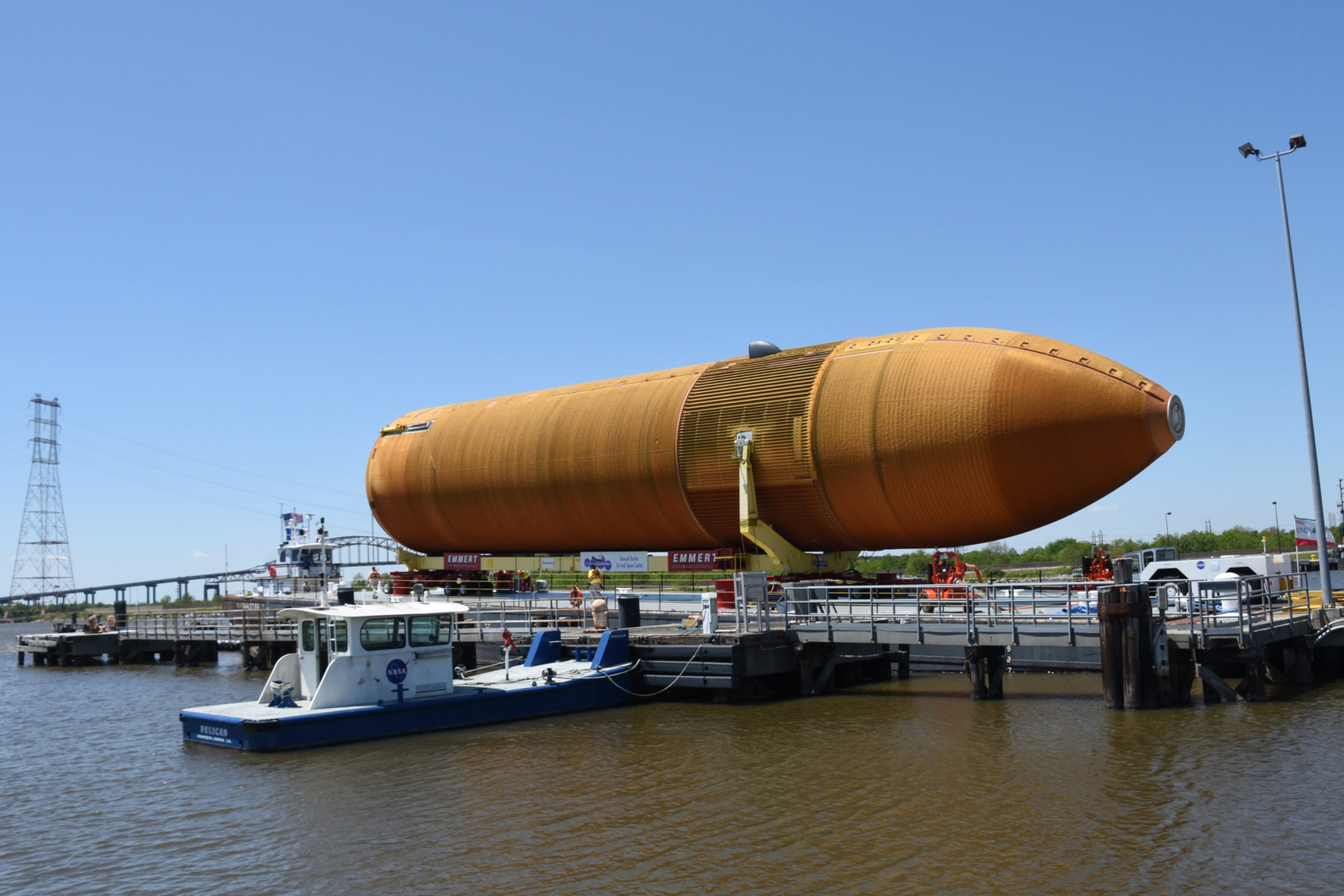Jason Davis • Apr 11, 2016
Last unflown space shuttle tank heads seaward for new mission
On a perfect, New Orleans spring morning, Bobby Watkins strolled alongside the last unflown space shuttle external fuel tank. The NASA Michoud Assembly Facility director was pointing out sections of the large, 49-meter cylinder that lacked the rust-colored foam covering the rest of the tank. Those sections had been sliced away, exposing patches of smooth, light-brown skin.
The cutouts were scars left by engineers trying to find out why space shuttle Columbia disintegrated back in 2003, killing seven astronauts. Investigations revealed a large chunk of foam dislodged from Columbia's external tank during ascent, striking the orbiter's wing. The hit damaged the orbiter's thermal protection system, leaving it defenseless against superheated plasma during reentry.
"You can see where they cut out sections of the foam," Watkins said, addressing a small cadre of reporters, photographers and videographers. "That's where they did a lot of analysis. They were really trying to understand: Was foam coming off the tank? If so, why was it coming off the tank?"

View our ET-94 photo gallery
The Planetary Society is following the journey of ET-94 from New Orleans to Los Angeles, via the Panama Canal. To see the entire photo gallery, visit our Flickr album.
Following the accident investigation, the tank—ET-94, officially—never flew. After the shuttles retired, Michoud began transitioning to its new role as the manufacturer of the Space Launch System, NASA's new heavy lift rocket set to debut in 2018. ET-94 was moved outdoors and left to bake under the Louisiana sun.
But after all these years, the tank finally has a new mission.
It is shipping by barge to Los Angeles, where it will meet up with Endeavour, the space shuttle orbiter currently on display at the California Science Center Samuel Oschin Pavilion. A pair of solid rocket boosters will be added to the tank, and the complete stack will be rotated into launch position. It will be the first—and only—post-shuttle-era flight stack.
"Pretty early on in this process we had our eyes on ET-94, knowing it was the last," said Jeffrey Rudolph, president and CEO of the California Science Center. "It took us three to four years talking to NASA about it get to the point where they agreed it would make sense; and in fact, they became very supportive of it."
The science center originally planned to construct a replica tank for Endeavour, as ET-94's fate was uncertain. At one point, NASA officials considered cannibalizing it for use in the Space Launch System program. But after that plan was scrapped, NASA agreed ET-94 would be better served joining Endeavour in Los Angeles.

On Sunday, a small vehicle resembling an airplane taxi truck pushed ET-94, cradled in a special dolly, down Michoud's Saturn Boulevard for the final time. It rolled across a dock onto the barge Gulfmaster I, and was lowered onto support stands and secured. The barge will ferry southward and is expected to pass through the Panama Canal during the last week of April. It will then head north along Baja California, arriving in Los Angeles after six to eight weeks at sea.
Before that happens, there's some final paperwork to sign. On Tuesday at noon, NASA officials will officially transfer the title to the science center during a ceremony before the barge departs.
"It's a bittersweet day," said Bobby Williams. For him, the tank represents the proud history of Michoud, and the employees that worked here during the shuttle program. "But we're moving it over to California," he said. "That's going to open it up for millions of folks to come and take a look at it, so we're very proud of that."
"You never know who's going to be inspired; what students, what teachers or what kids are going to be inspired, who look at things slightly different when you start talking about science and math and engineering. It's the right thing to do," said Watkins.
Expenses for this reporting project were covered by a partnership between The Planetary Society, California Science Center and Toyota.

Support our core enterprises
Your support powers our mission to explore worlds, find life, and defend Earth. You make all the difference when you make a gift. Give today!
Donate

 Explore Worlds
Explore Worlds Find Life
Find Life Defend Earth
Defend Earth


